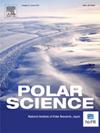大气和海洋过程对南大洋南极地区夏季海冰年际减少(2016-2017 年)的作用
IF 1.5
4区 地球科学
Q3 ECOLOGY
引用次数: 0
摘要
本文利用全球海洋海冰耦合模式和卫星观测,研究了 2013-2018 年间南极海冰区海冰的年际变化。数值模式合理地模拟了卫星观测到的南大洋南极海冰区夏季(12 月-2 月)、秋季(3 月-5 月)、冬季(6 月-8 月)和春季(9 月-11 月)海冰浓度(SIC)和海面温度(SST)的年际变化。本文章由计算机程序翻译,如有差异,请以英文原文为准。
Role of atmospheric and oceanic processes on interannual summertime (2016–2017) decrease of sea ice in the Antarctic regions of the Southern Ocean
In this article, the interannual variability of sea ice in the Antarctic sea ice regions between 2013–2018 is studied using a global ocean sea ice coupled model and satellite observation. The numerical model reasonably well simulates satellite observed interannual variability of sea ice concentration (SIC) and sea surface temperature (SST) in the Antarctic regions of Southern Ocean during all four austral seasons; summer (December–February), autumn (March–May), winter (June–August), and spring (September–November).
A comparison of satellite and model shows that, during last two decades between 2001–2020, summertime of 2016–2017 had the lowest (highest) SIC (SST) across the Antarctic sea ice regions. Mixed layer heat budget analysis has been performed to comprehend how thermodynamic processes affect changes in SIC and SST in the Antarctic sea ice regions. The strong positive net atmospheric heat flux and the negative ocean vertical entrainment during summertime of 2016–2017 resulted in increased SST compared to other years, which lead to decreased SIC during above years. Also, loss of sea ice during summertime of 2016–2017 in the Antarctic sea ice regions are linked with significant decrease of wind stress magnitude and increase of wind stress curl.
求助全文
通过发布文献求助,成功后即可免费获取论文全文。
去求助
来源期刊

Polar Science
ECOLOGY-GEOSCIENCES, MULTIDISCIPLINARY
CiteScore
3.90
自引率
5.60%
发文量
46
期刊介绍:
Polar Science is an international, peer-reviewed quarterly journal. It is dedicated to publishing original research articles for sciences relating to the polar regions of the Earth and other planets. Polar Science aims to cover 15 disciplines which are listed below; they cover most aspects of physical sciences, geosciences and life sciences, together with engineering and social sciences. Articles should attract the interest of broad polar science communities, and not be limited to the interests of those who work under specific research subjects. Polar Science also has an Open Archive whereby published articles are made freely available from ScienceDirect after an embargo period of 24 months from the date of publication.
- Space and upper atmosphere physics
- Atmospheric science/climatology
- Glaciology
- Oceanography/sea ice studies
- Geology/petrology
- Solid earth geophysics/seismology
- Marine Earth science
- Geomorphology/Cenozoic-Quaternary geology
- Meteoritics
- Terrestrial biology
- Marine biology
- Animal ecology
- Environment
- Polar Engineering
- Humanities and social sciences.
 求助内容:
求助内容: 应助结果提醒方式:
应助结果提醒方式:


